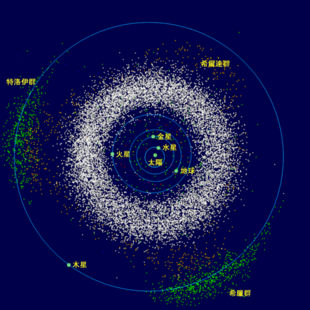特洛伊天体

在天文学,特洛伊天体是与一颗较大的天体共享轨道的小天体(主要是小行星)。这些小天体在主天体前方或后方约60°,靠近其轨道上的L4[锚点失效]或L5[锚点失效]拉格朗日点上稳定的运行。特洛伊天体可以与行星或大型天然卫星共享其轨道。
特洛伊是一种类型的共轨天体。在这种排列中,一颗恒星和一颗行星围绕其共同的重心运行,该重心靠近恒星的中心,因为它通常比绕轨道运行的行星质量大得多。反过来,一颗比恒星和行星都小得多的质量,位于恒星-行星系统的拉格朗日点之一,受到通过该重心作用的组合引力的影响。因此,最小的物体以与行星相同的轨道周期绕重心运行,并且随着时间的推移,排列可以保持稳定[1]。
在太阳系中,大多数已知的特洛伊天体共享木星轨道,它们被称为木星特洛伊,并分成在L4的希腊营(在木星前方)和在L5特洛伊营(在木星后方),大约有超过一百万颗大于一公里的木星特洛伊存在着[2],但现实已编目的仅有其中的7000多颗。在其它行星的轨道上,迄今为止只发现了9颗火星特洛伊、28颗海王星特洛伊、2颗天王星特洛伊和两颗地球特洛伊;一颗临时的金星特洛伊也是已知的。数值轨道动力学稳定性模拟表明,土星可能没有任何原始的特洛伊天体[3]。
当主天体是一颗行星、次要天体是它的一颗卫星时也会出现同样的排列,使小得多的特洛伊卫星可以共享其轨道。所有已知的特洛伊卫星都是土星系统的一部分。土卫十三(Telesto)和土卫十四(Calypso)是土卫三(Tethys)的特洛伊天体,而土卫十二(Helene)和土卫三十四(Polydeuces)是土卫四(Dione)的特洛伊天体。
特洛伊小行星
1772年,意大利-法国的数学家和天文学家约瑟夫·路易士·拉格朗日得到了一般三体问题的两个常模解(共线和等边)[4]。在受限三体问题中,一个质量可以忽略不计(拉格朗日没有考虑),该质量的五个可能位置现在被称为拉格朗日点。
“特洛伊”一词最初指的是轨道靠近木星拉格朗日点的特洛伊小行星。这些特洛伊天体长期以来一直以希腊神话中的特洛伊战争人物命名。按照惯例,在木星L4点附近运行的小行星是以战争中希腊方面的人物命名的,而在木星L5点附近轨道运行的小行星则来自特洛伊方面。但有两个例外,它们是在公约制定之前命名的,希腊的(624) 赫克特(英语:Hektor)和特洛伊的(617) 帕特罗克洛斯(英语:Patroclus)[5]。
天文学家估计木星特洛伊的数量大约与小行星带的小行星数量一样多[6]。
后来,人们发现了在海王星、火星和地球的拉格朗日点附近运行的天体[7],以及天王星和金星也有。在木星以外行星的拉格朗日点上的小行星可能被称为拉格朗日小行星[8]。
- 已知的火星特洛伊:有4颗:(5261) 尤里卡(英语:Eureka)、(101429) 1998 VF31、(311999) 2007 NS2、和(121514) 1999 UJ7:唯一在L4前导“云”的火星特洛伊天体[9][10],似乎还有2001 DH47、2011 SC191和2011 UN63,但这些尚未被小行星中心认可。
- 已知有28颗海王星特洛伊[11],但预期海王星的大型特洛伊数量将比木星的大型特洛伊多出一个数量级[12][13]。
- 2010 TK7于2011年被确认为已知的第一颗地球特洛伊。它位于L4拉格朗日点,该点位于地球前面[14]。2020 XL5在2021年被发现是另一颗地球特洛伊。它也位于L4[15][16]。
- 2011 QF99于2013年被确认为第一颗天王星特洛伊。它位于 L4拉格朗日点。2014 YX49于2017年被宣告[17]。
- 2013 ND15是一颗临时的金星特洛伊,也是第一颗被识别的金星特洛伊。
- 大型小行星谷神星(矮行星)和灶神星有临时的特洛伊小行星[18]。
行星的特洛伊天体
| 行星 | 在L4的数量 | 在L5的数量 | L4列表 | L5列表 |
|---|---|---|---|---|
| 水星 | 0 | 0 | — | — |
| 金星 | 1 | 0 | 2013 ND15 | — |
| 地球 | 2 | 0 | 2010 TK7,2020 XL5 | — |
| 火星 | 1 | 13 | (121514) 1999 UJ7 | 许多 |
| 木星 | 7508 | 4044 | 许多 | 许多 |
| 土星 | 0 | 0 | — | — |
| 天王星 | 2 | 0 | 2011 QF99,2014 YX49 | — |
| 海王星 | 24 | 4 | 许多 | 许多 |
卫星的特洛伊天体
| 卫星 | 在L4的数量 | 在L5的数量 | L4列表 | L5列表 |
|---|---|---|---|---|
| 土卫三 | 1 | 1 | 土卫十三 | 土卫十四 |
| 土卫四 | 1 | 1 | 土卫十二 | 土卫三十四 |
稳定性
一个由恒星、行星和特洛伊天体组成的系统是否稳定,取决于它受到的扰动有多大。例如,这颗行星的质量如果与地球相当,并且还有一个木星质量的物体围绕这颗恒星运行,那么特洛伊天体的轨道将远不如第二颗行星的质量如同冥王星质量时稳定。
根据经验,如果m1 > 100m2 > 10,000m3(此处的m1,m2,和 m3,分别是恒星、行星、和特洛伊天体的质量。)。
更正式一点,在具有圆形轨道的三体系统中,稳定性条件为27(m1m2 + m2m3 + m3m1) < (m1 + m2 + m3)2。所以特洛伊天体是一粒尘埃, m3→0,强加上的下限为m1/m2是25+√621/2 ≈ 24.9599。 如果这颗恒星是超大质量的,m1→+∞,则在牛顿引力下,无论行星和特洛伊的质量如何,系统都是稳定的。并且如果 m1/m2 = m2/m3,则两者都必须超过13+√168 ≈ 25.9615。然而,这一切都假定是一个三体系统;一旦引入其它物体,即使距离遥远且体积较小,系统也需要更大的比率值才能有足够的稳定性。
行星特洛伊的轨道动画

太阳 · 金星 · 2013 ND15

太阳 · 地球 · 2020 XL5

太阳 · 1999 UJ7 · 火星

太阳 · 2007 NS2 · 火星

太阳 · 2011 QF99 · 天王星

太阳 · 2014 YX49 · 天王星

参考文献
- ^ Robutel, Philippe; Souchay, Jean, An introduction to the dynamics of trojan asteroids, Dvorak, Rudolf; Souchay, Jean (编), Dynamics of Small Solar System Bodies and Exoplanets, Lecture Notes in Physics 790, Springer: 197, 2010, ISBN 978-3-642-04457-1
- ^ Yoshida, F.; Nakamura, T. Size Distribution of Faint Jovian L4 Trojan Asteroids. The Astronomical Journal. Dec 2005, 130 (6): 2900–2911. Bibcode:2005AJ....130.2900Y. doi:10.1086/497571
 .
.
- ^ Sheppard, Scott S.; Trujillo, Chadwick A. A Thick Cloud of Neptune Trojans and their Colors. Science. June 2006, 313 (5786): 511–514. Bibcode:2006Sci...313..511S. PMID 16778021. S2CID 35721399. doi:10.1126/science.1127173.
- ^ Lagrange, Joseph-Louis. Essai sur le Problème des Trois Corps [Essay on the Three-Body Problem] (PDF). 1772. (原始内容 (PDF)存档于22 December 2017) (法语).
- ^ Wright, Alison. Planetary science: The Trojan is out there. Nature Physics. 1 August 2011, 7 (8): 592. Bibcode:2011NatPh...7..592W. doi:10.1038/nphys2061
 .
.
- ^ Yoshida, Fumi; Nakamura, Tsuko. Size distribution of faint L4 Trojan asteroids. The Astronomical Journal. 2005, 130 (6): 2900–11. Bibcode:2005AJ....130.2900Y. doi:10.1086/497571
 .
.
- ^ Connors, Martin; Wiegert, Paul; Veillet, Christian. Earth's Trojan asteroid. Nature. 27 July 2011, 475 (7357): 481–483. Bibcode:2011Natur.475..481C. PMID 21796207. S2CID 205225571. doi:10.1038/nature10233.
- ^ Whiteley, Robert J.; Tholen, David J. A CCD Search for Lagrangian Asteroids of the Earth–Sun System. Icarus. November 1998, 136 (1): 154–167. Bibcode:1998Icar..136..154W. doi:10.1006/icar.1998.5995.
- ^ List of Martian Trojans. Minor Planet Center. [3 July 2015]. (原始内容存档于2012-05-11).
- ^ de la Fuente Marcos, C.; de la Fuente Marcos, R. Three new stable L5 Mars Trojans. Letters. Monthly Notices of the Royal Astronomical Society. 15 May 2013, 432 (1): 31–35. Bibcode:2013MNRAS.432L..31D. arXiv:1303.0124
 . doi:10.1093/mnrasl/slt028.
. doi:10.1093/mnrasl/slt028.
- ^ List of Neptune Trojans. Minor Planet Center. 28 October 2018 [28 December 2018]. (原始内容存档于2017-07-29).
- ^ Chiang, Eugene I.; Lithwick, Yoram. Neptune Trojans as a Testbed for Planet Formation. The Astrophysical Journal. 20 July 2005, 628 (1): 520–532. Bibcode:2005ApJ...628..520C. S2CID 18509704. arXiv:astro-ph/0502276
 . doi:10.1086/430825.
. doi:10.1086/430825.
- ^ Powell, David. Neptune May Have Thousands of Escorts. Space.com. 30 January 2007 [2023-11-07]. (原始内容存档于2012-07-18).
- ^ Choi, Charles Q. First Asteroid Companion of Earth Discovered at Last. Space.com. 27 July 2011 [27 July 2011]. (原始内容存档于2013-08-26).
- ^ Man-To Hui; et al. The Second Earth Trojan 2020 XL5. Astrophysical Journal Letters. Nov 2021, 922 (2): L25. Bibcode:2021ApJ...922L..25H. ISSN 2041-8205. S2CID 243860678. arXiv:2111.05058
 . doi:10.3847/2041-8213/ac37bf
. doi:10.3847/2041-8213/ac37bf  .
.
- ^ Leah Crane. Trojan asteroid: Another object found that shares Earth's orbit. New Scientist. Nov 22, 2021 [2023-11-07]. (原始内容存档于2023-11-08).
- ^ de la Fuente Marcos, Carlos; de la Fuente Marcos, Raúl. Asteroid 2014 YX49: a large transient Trojan of Uranus. Monthly Notices of the Royal Astronomical Society. 21 May 2017, 467 (2): 1561–1568. Bibcode:2017MNRAS.467.1561D. arXiv:1701.05541
 . doi:10.1093/mnras/stx197.
. doi:10.1093/mnras/stx197.
- ^ Christou, Apostolos A.; Wiegert, Paul. A population of main belt asteroids co-orbiting with Ceres and Vesta. Icarus. January 2012, 217 (1): 27–42. Bibcode:2012Icar..217...27C. S2CID 59474402. arXiv:1110.4810
 . doi:10.1016/j.icarus.2011.10.016.
. doi:10.1016/j.icarus.2011.10.016.
相关条目
参考资料
| |||||||||||||||||||||||||||||||||||||||||||||||||||
| ||||||||||||||||||||||||||||||||||||||||||||||||||||||||||||||||||||
| ||||||||||||||||||||||||
| ||||||||||||||||||||||||||||||||||||||||||||||||||||||||||||||||||
Text is available under the CC BY-SA 4.0 license; additional terms may apply.
Images, videos and audio are available under their respective licenses.









